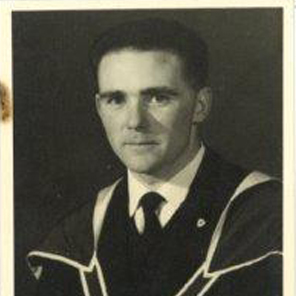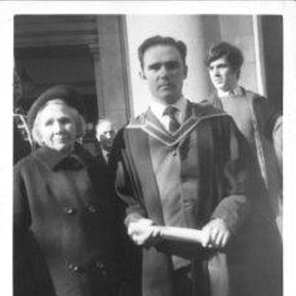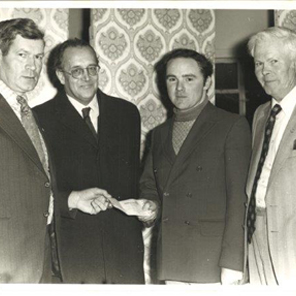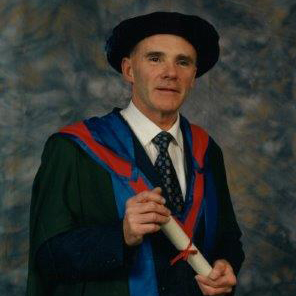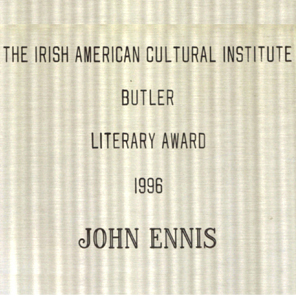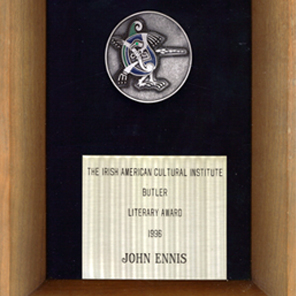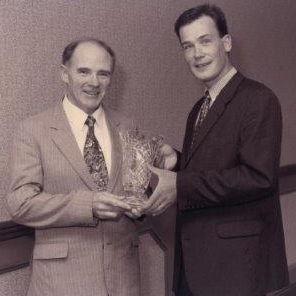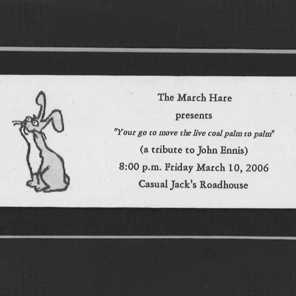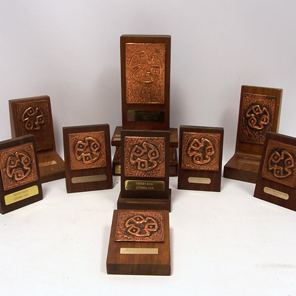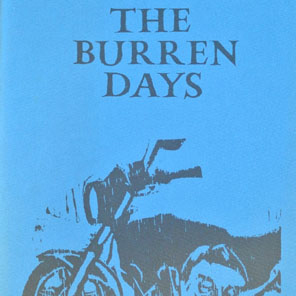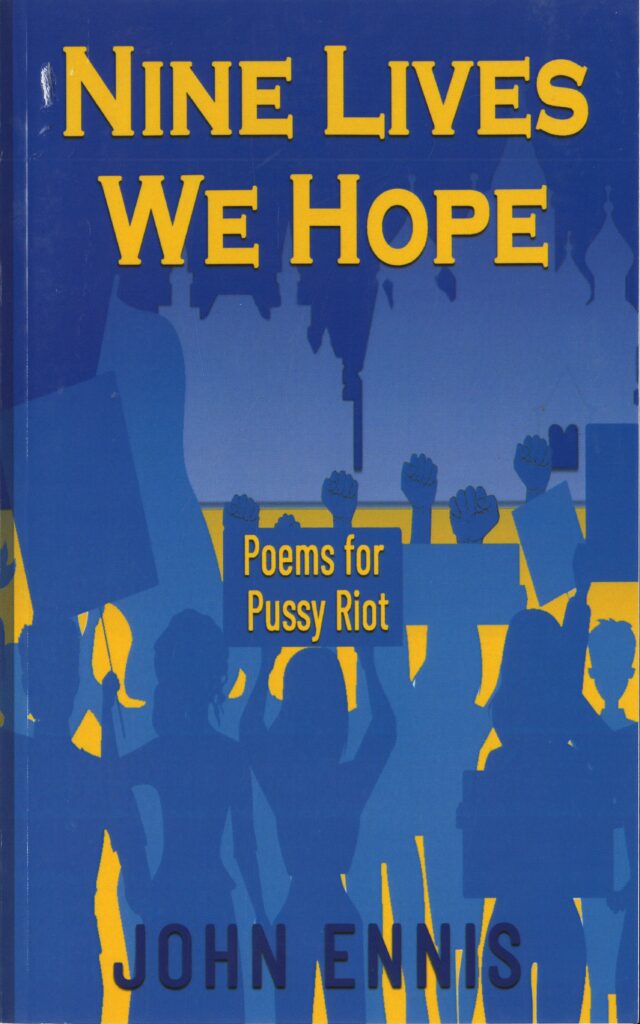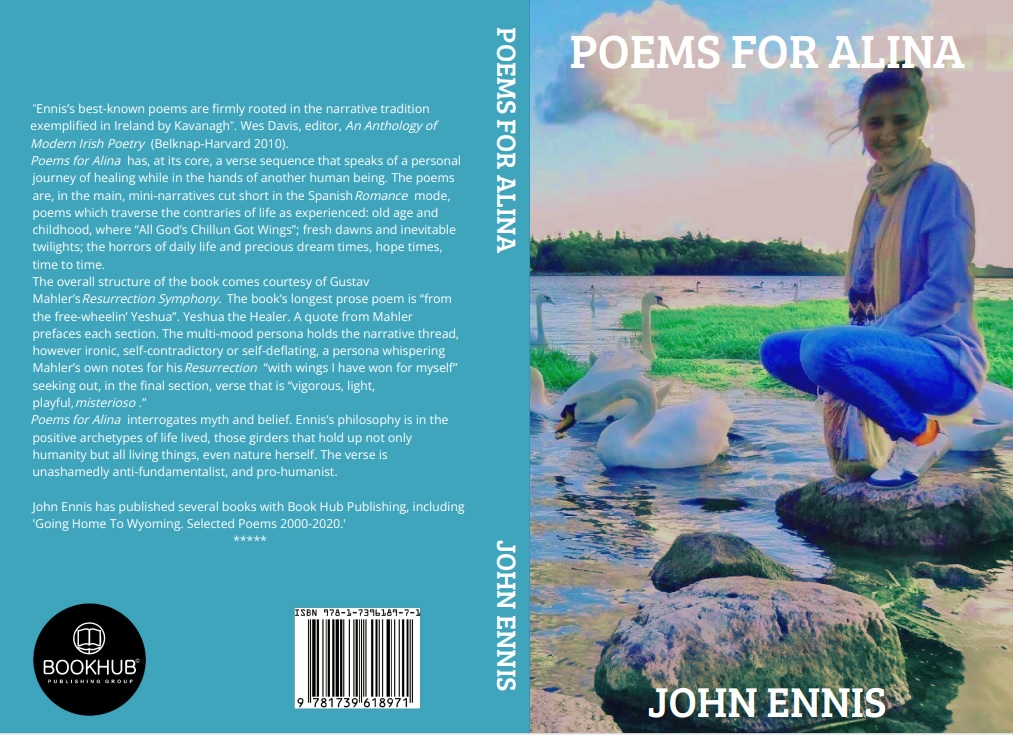
Night on Hibernia | 1976
“Night on Hibernia is John Ennis’s first volume and it includes most of the poems that won the author the Patrick Kavanagh Award last year. Mr. Ennis obviously admires and has a poetic affinity with the ill-starred Hart Crane, that dazzling American poet who committed suicide in his early thirties. Like Crane, John Ennis’s imagery is richly exuberant, yet firmly controlled; and, like Crane, the sea stimulates his imaginative powers. The long poem – more than, say, 40 lines – is a considerable test of poetic stamina. Long poems, especially by those who are expert at the concentrated lyric, tend toward flatness and, more often than not pad along to a limp conclusion. Mr. Ennis gives us two successful long poems, both of them character studies, in which the pressure seldom slackens. On the strength of Night on Hibernia, I should say that Mr. Ennis has definitely arrived”.
Robert Greacen, The Irish Press, 21 August 1976.

Dolmen Hill | 1977
“Dolmen Hill is the second collection of Westmeath man, John Ennis, and includes ‘Orpheus’, which won the open poetry competition at Listowel last year, also ‘Corbetstown’ a prizewinner at Listowel in 1976. ‘Orpheus’ runs to 48 pages and is brilliant literary entertainment: ‘Rilke! Say die no more! Onward Poesy’s Phagocytes! / Remember the limestone lips softly sonneting shut. / Poets hitch themselves to Orpheus as fervently as patients / Plugging in to a Chrome Kidney Machine. After you, / Rainer Marie . . .”
Kevin Faller, The Irish Independent, 18 April 1978.
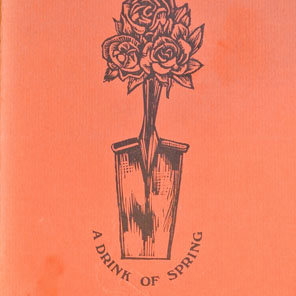
A Drink of Spring | 1979
“A Drink of Spring as well as containing poems individually highly organised in unity of mood and image, develops Ennis’s unique skills as poem-builder, sequence-builder, into such a unified achievement as this book, which becomes, indeed, almost one long poem in parts. The collection is altogether concerned with the death of the poet’s father and contains one of the fullest accounts of a relationship between father and son that I have read. The poems move through three distinct cycles which come across as ordered as the ceremonies of Holy Week and ordered into Holy Thursday, Good Friday and the Resurrection Vigil. The concerns of the book do, in fact, relate to these three days in a thematic way, also: there is the recollection of the sharing of a life in all its fullness, its rites . . .” John F. Deane, Irish Independent.
READ MORE – Listowel Citations
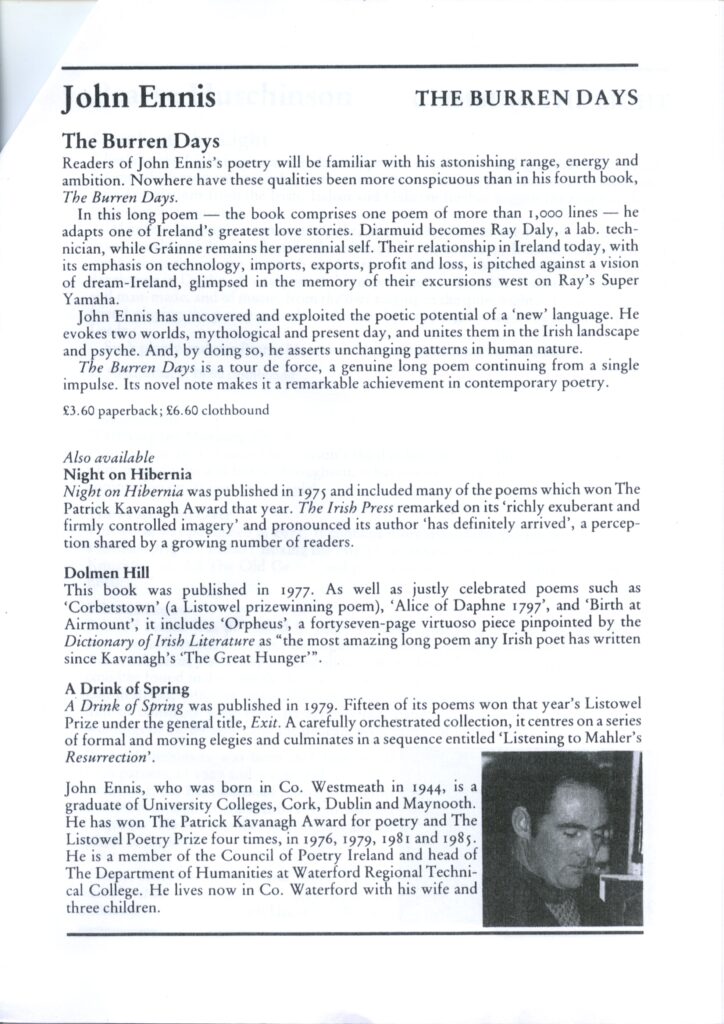
The Burren Days | 1985
“The thing has terrific verve and originality and pleasure: the sense of something, as Frost said, ‘common in experience but uncommon in books’ is delightful. The factory-scape of the working week and the landscape of love and memory are beautifully cross-cut, like the psychic cross-cutting between the ‘80’s Ireland and dream Ireland. The country is seen again, not a fake aisling Ireland, but tarmac and concrete and slurry and traffic, and all this is beautiful and ordinary at once. The pregnancy worry is so good too, again sociologically right and psychologically good in releasing the dreams of erotic life in Ray . . . I found it a powerful medium for ‘getting in’ a lot of actuality and lyricism cheek by jowl. There’s a terrific sense of honest-to-God energy, and a sense of the poet behind it all as a man with a composed soul and free spirit. Also, it really is a single rush of inspiration, extraordinary in a thing so long . . .”
Seamus Heaney Letter
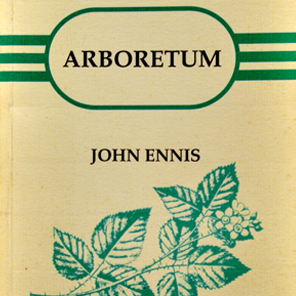
Arboretum | 1990
“John Ennis has produced that wondrous thing, a long poem. On a family outing to an arboretum he sees that it is a kind of microcosm of the earth, of all its territories and its peoples. This sparks off reflections on nature, history and humanity, interspersed with the sensuous immediacies of earth and leaf. Its multiple directions are firmly framed within the passing of the day. An unusual and accomplished work. ”
Hugh Bredin, Fortnight

In a Green Shade | 1991
“. . . John Ennis’s poetry is furthermore remarkable as a testament to intellectual excitement, where the veil of the ordinary is torn by sudden disclosures as in the poems on the suppression of protest at Tienanmen Square, and on the death of Patrick White. In the latter, ‘The Tree of Man’, we witness the place occupied by literature in the poet’s responses:
When I panicked in the centre of the field with the stream
Rattling at one end, there were your pages only to return to.
I put one rooted foot in front of the other, one at a time,
Struggled back for Amy, the rag and bone of Sarsaparilla
In bloom, Down at the Dump, the greatest story ever told.
Seán Lysaght, Poetry Ireland Review 36
Down in the Deeper Helicon | 1994
“John Ennis’s book deserves a more grand description than a ‘collection’ of poems. It is more than a series of pieces, it is a body of work, dense, cerebral, scholarly. If you are going to read Ennis on the bus, bring a dictionary. I had to pick my way through, re-reading, catching echoes . . .Studded with quotes and intimate one-way conversations with the great figures of literature and art, it is a book of themes; the intellectual concerns of poetry, muse and inspiration, set in the sweeping arenas of history, mythology, and ancient lore. Although loosely rooted in place, the poems feel universal, timeless . . .
Sara Berkeley, Poetry Ireland Review 48
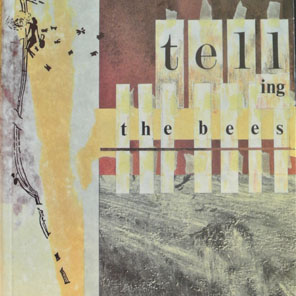
Telling the Bees | 1995
Three of the award-winning long poems from Listowel Writers’ Week. “Letter to Connla”. Never written. In the mind to be. Illuminator, twin-brother, alter ego Connla, somewhere on the Continent remembered by his unnamed twin riding his chariot and four through land sown up by filidh, breitheamhs and church men. Stealer of secret vellum for the letter, tracked down. “This Other Umbria”. Old stroke-disabled speechless Bianconi sees his life flash by in a vision of horses and curtal sonnets. “Telling the Bees”. Kavanaghesque. Well, Almost Everything.
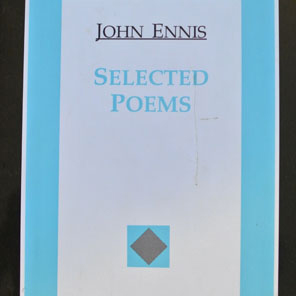
Selected Poems | 1996
“Nothing human (nor animal, nor ‘supernatural’) is alien to this poet. He can watch ants drowning in the nest he has accidentally knocked into a pond with as intense and genuine a dismay as that with which he laments the murdered students of Tienanmen Square. Buddha and Krishna as well as Christ are spiritual forces in his work, while moving from the universal to the parish, he has written in ‘Lemongrove’ an evocation of local religious differences as tender and tactful as Heaney’s ‘The Other Side’, though with a brisker sting in its tail: ‘So, Billy, I’d come to pay my respects. Again, to say hello. / You gripped my hand hard. I wondered when you’d let it go’. At heart he seems to be a pantheist, devoted to ‘the one true church of the fields’ rather than to any institutionalised religion”.
Carol Rumens, “An Ecstatic Writer”, Poetry Ireland Review 53.
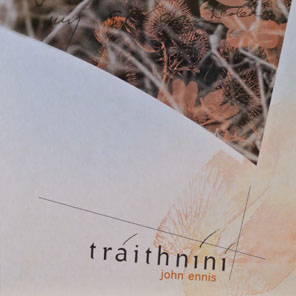
Tráithníní | 2000
“It is possible for a reader to cruise through Emily Dickinson’s poems in an hour – bouncing along on her rhythms, seeing (but not seeing) the passing landscape, hearing (but barely) the poems’ hum . . . So it is with John Ennis’s new book of poems . . . Its one hundred poems lack titles, many are even shorter than Dickinson’s briefest works . . . Though the author says of Tráithníní that ‘these poems / . . . [know] nothing / but their falling’ they also ‘settle / as my one / testimony’, prove that ‘this / shuddering / of stem’ is not a final death. Or, ironically, that writing is a little death all its own, an attempt at survival, a ‘Maybe’. Writers and stubbled fields alike are ‘hosts / most days’, dependent on the hunger of others for their usefulness. And so John Ennis enters his own room where he might say, along with Dickinson, his ‘Message is committed / To Hands [he] cannot see’. It is a message, and a collection, worth taking the slow route through – particularly to savour its great vocabulary of the earth of which we are all tenants.”
Tracy Youngblom New Hibernia Review, Spring 2001
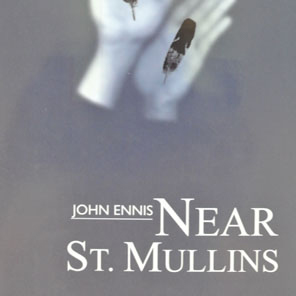
Near St. Mullins | 2002
“ . . . the poem is full of satisfyingly beautiful writing, some of it rich and lyrical, some of it as appealingly bare as an early Irish poem or, indeed (I hope I’m not mixing my drinks here!) an Anglo-Saxon one. All of which, I suppose, is a way of saying that – astonishingly – you have struck yet another note in this work, different not only to your earlier poems but yet different to what others like Heaney, Montague and Padraic Fallon have done with Sweeney. Your resourcefulness never ceases to amaze . . . I should say too that I found the poem extremely moving, full of poignancy and tenderness. Above all, it is true to the spirit of section XXIV – kindling a myth for our ‘inward darkness’.
Dennis O’Driscoll Letter to author.
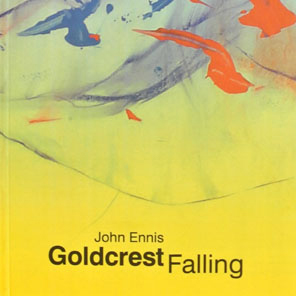
Goldcrest Falling | 2006
“Your Goldcrest Falling has been roosting on various shelves since last April, but I broke his fall this evening and got great pleasure from the experience. There’s something wonderfully untrammelled in the writing yet something held and holding (like those slates) at the core. Such truth to memory and the moment and yet such extravagance. I could almost share your own delight as you caught things on the wing, and thought them as fleeting too. ‘Oisins on Tractors’ as Frost said, common in experience, but uncommon in books. The firetamers and that boy among sparrows sequence are both gleeful and (those dehorned bullocks) grievous. And a particular joy for me to come on the word ‘strigged’ –deep down in my own byre speak, never seen until now on a page. Anyhow – here’s to you.”
Seamus Heaney Letter to author.
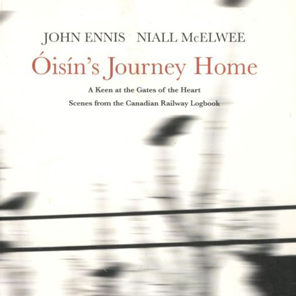
Oisin’s Journey Home | 2006
“The Newfoundland Railway is a part of the proud and rich history of Canada’s most easterly province. . . Dr. John Ennis has written a book of poetry [on the railway]and he officially launched it last Monday at the Port aux Basques Railway Heritage Centre . . . The book is called Oisín’s Journey Home, ‘A Keen at the Gates of the Heart’, all the proceeds go to [our] railway heritage centers . . . He chose to hold the launch in Port aux Basques in honour of the local town council, which at the time of the closure of the railway, said ‘no, we’re not going to accept this’. The story leads up to that point in history as the climax for the poem. There, on page 38, is printed Homage to the Town Council of Port aux Basques – a recall of the events in St. John’s where the town council walked out of the Radisson where government’s plan to remove the railway progressed.”
Mandy Ryan, The Gulf News 06 / 09 / 2006

Postponing Ásbyrgi | 2013
“In his fascinating and perhaps most ambitious collection to date, Ennis turns his attention north . . . to Iceland through the unlikely inspiration of the post-rock band Sìgur Rós. Ennis came relatively late to the band, only discovering them for the first time in 2011 while watching the award-winning 2007 documentary Heima, (Icelandic for “home”) which tracked a series of free concerts Sìgur Rós gave in Iceland. Ennis fell for the band, hook, line and sinker, and has been strongly under the Sìgur Rós spell ever since. Now that spell has transmuted into a book of remarkable poems that responds to their music . . . Ennis strikes the right note in this formally layered and nuanced love letter to one of Iceland’s most innovative bands. The poems’ compressed expressions of warmth, intensity and startling metaphoric resonance reflect some of the moments of ecstasy and magic that occur as you listen to Sìgur Rós. Those unfamiliar with their music will be inspired to seek them out, while current fans will be transported further into [their] enigmatic and ethereal translucence . . .”
Adam Wyeth, Southword 24.
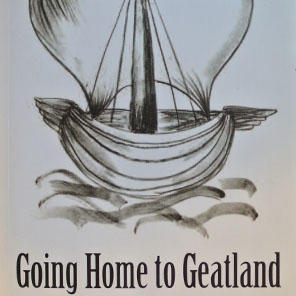
Going Home to Geatland | 2014
The book attempts a broad canvas: it is a foray of sequences and leads off with a brave Beowulf reflecting on his times, where the winning of the dragon’s gold for his people has been a step too far. Thomas Mann’s Hans Castorp, recovered from TB on The Magic Mountain, enlists for the Kaiser and prepares the ground for Mein Kampf. Henry Luttrell remembers Aughrim as he minds the doll Ériu for his daughter within the walls of his Kildare estate. “The Somewhere Sonnets” commences with a young teenager, last of her line, trying to find her glasses in eternity in the besieged Syrian city of Qatna. “And the Times then so Barbarous”, – were they ever, are they ever, any other? “Champions” pass by, an unlikely bunch often, among them old ”doddery” Ronnie and Michail at Hofði, Chief Cleleman by the Pacific, Kunchok Tsephel Gopey Tsang in a prison in Tibet, Nelson and Lorca. There are sonnets of praise, too, “O When the Saints” – for those who wade in on the beaches at Normandy to regain whatever freedoms we still have in these parts; “A Man of Chivalry Returns” – midlander Seán McKeon, who in the spirit of the Táin combatants, dresses the wounds of enemy soldiers ambushed in The War of Independence. Old betrayed vets get a listen to. “Gaza Ground Zero” roots for Palestine and the olives, and is dedicated to Yaron Caplan IOF, in prison for his refusal to serve. “Lines for Moor Mahomed Taraki”, poet and assassinated president of Afghanistan critiques global western expansionism in his own country. So, too, in Iraq and Darfur. Chief Big Tree of the Cheyenne Nation leads cast and reader in “Going Home to Wyoming”, a Here-Comes-Everybody, where the Jerusalem Berserker makes a Guest Appearance from the Temple.

A Pullet for Jack | 2014
“[It] is the nearness . . . of family . . . that animates the collection – family that in all its bickering and its small nobilities, becomes its own mythology. To children, the world of adults is always exaggerated in size. Now, looking back with Ennis, we realize that our families were indeed giants on the earth. John Ennis puts his finger on the central mystery of memory, the paradox that when we recall an incident, a face, or an object with particularity we also participate in the universal.”
James Silas Rogers, Editor, New Hibernia Review.
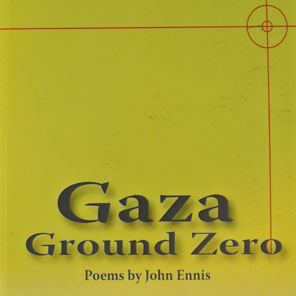
Gaza Ground Zero | 2015
This chapbook is about the ongoing destruction of Palestine. In the murders of young people Ali Safi, Jihad Shehada al-Jaafari and Muhammad Murad Yahiya, the murders of thousands. In the eviction from their house of brothers Nureddin Amro, his brother Sharif Amro and their families, the eviction of a race. In the uprooting of the olives, the attempted elimination of a civilisation. The cancer that is Israeli expansionism remains aided and abetted by world nations. Still, –like the golden beauty of the mustard seed, thrown up by Israeli bombing, to bloom again, which suffuses the cover of the slim volume –
“Smallest of seeds, birds sing in its branches, in the world’s forgotten estimation,
Palestine lives. In all its dereliction by the
Mediterranean, one proud nation”.
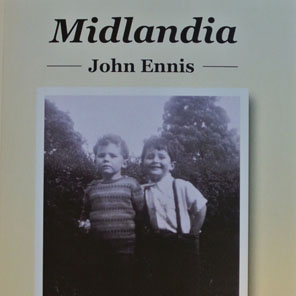
Midlandia | 2015
Midlandia is the final work in the author’s Testament for Home (Postponing Ásbyrgi 2012, Going Home to Geatland 2013, and A Pullet for Jack 2014). Midlandia celebrates the wider Irish midland landscape of town and country, its people and the mystic Uisneach at the heart of the place. No lyric jaunt, the book attempts to embrace both the ugly and the awesome in local humanity. The work takes its cue from the Findlandia of Sibelius. The style is a similar plein air.
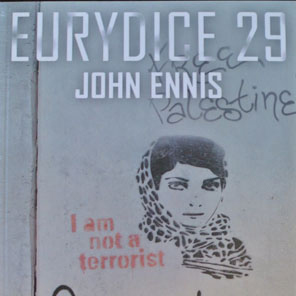
Eurydice 29 | 2016
The book begins with a long poem dedicated to local heroines, sisters Eilís and Emily Elliott of Goldsmith’s Glasson, who were in the thick of the 1916 Insurrection in Dublin, one sister no less brave than the other. Eilís was among the last group to surrender. With a change of clothing, a hold all of revolvers, and hiding all night in a vestry, she walked out among the mass goers the next morning. In the days that followed, she aided the widows of dead revolutionaries. Emily survived too, but like her sister had a tough time of it in the ensuing War of Independence. Her business with her husband was continually wrecked by crown forces. Both sisters by trade were master confectioners. Standing alongside the sisters are other brave women, some Irish, the women of Limerick, Londonderry, New Ross, Betsy Gray of Dungannon, La Pasionaria, Khalida Jarrar, Farkhunda Malikzada . . .
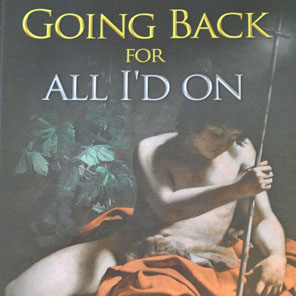
Going Back for all I’d on… | 2017
The story of Yeshua (known as Jesus in these parts) pieced together imaginatively from non-imprimatur studies of his native Jewish tradition. A man starting his public life as strapping moralist on the Messiah trail, gradually jettisoning notions of the Chosen, and ending his days as anarchist in the Jerusalem Temple. Along the way, meet his bosom cousin John, who courtesy of Caravaggio graces the cover, beloveds, partner Mary, mother Mary, Joseph, blood-father Abdes, sisters, brothers, and his kids who watch from “a farther hill” his last hours on Golgotha.
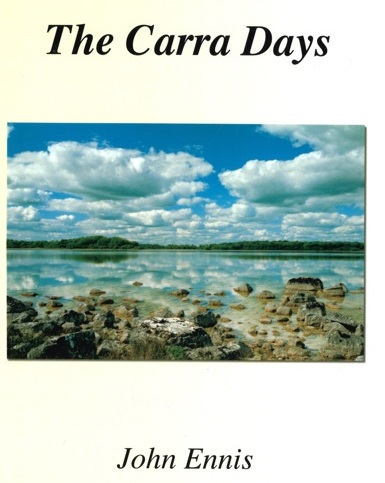
The Carra Days | 2018
Dairbhre Press
John Ennis has found a poetic mother lode in his ‘retirement’ and his latest collection of poetry, The Carra Days, revisits his time in a junior seminary in the early sixties. Teenagers were prepared for the African Missions at Ballinafad (The Fad) in Co Mayo near Lough Carra. It was a time, described by historian, Joe Lee, as “one of the more remarkable conquests of the age of imperialism”. The language of the Missionary texts used words like ‘pagans’, ‘darkness’, ‘savagery’, and ‘superstition’. Irish Catholics were beseeched to “help us to make poor abandoned Africa a Holy Ireland beyond the seas”.
The narrative poems use ‘personae’ to mask the real people, and it is the story of Fintan Daly, being welcomed by a Dean of Studies outlining to 15-year-olds a rigid litany of ‘next year the Inter, then the Leaving, a spiritual year, possibly University, or sent to man a school on the Niger. Then Canon Law, Philosophy, Theology’.
No wonder these boys found a temporal paradise in Lough Carra to avoid the family ‘shame’ of being “chucked” or sent home to an even more unsympathetic world. Those boys were described as being akin to those in William Blake’s ‘Songs of Innocence and Experience’.
Some were described, mostly with nostalgic fondness – the most ‘exotic’ an Irish American boy, Oisín, who dropped out and “joined a squadron back in the States, dropping hosts of bombs on North Vietnam”.
Or in ‘After the Game’ -“these two just fell into each other’s arms in a narrow bed” – no special friendships.
The teaching staff were either fondly remembered or hinted at for their rigid, Loyola army talk.
What sings out in this book is the music of the poetry, the sounds and selection of words and the snatches of songs of the era. Pat Boone on the radio ‘April Love’ or Al Jolson’s ‘April Showers’. In ‘A Dream Of Ben Conducting’ there was ‘Men Of Harlech’, ‘Camptown Races’, ‘Jeanie With The Light Brown Hair’, ‘Beautiful Dreamer’, ‘The Isle Of Capri’, ‘Hucklebuck’, ‘Sloop John B’, and ‘Westmeath Bachelor’.
By the end of the book, there is a wonderful epiphany, forgetting “the rule embittered year” where even fleeting “erections” were like a dream time beside a lake “little aftermath for analysis” and the last phrase – “memory that will last’.
(Liam Murphy, The Munster Express, 12 February 2019).
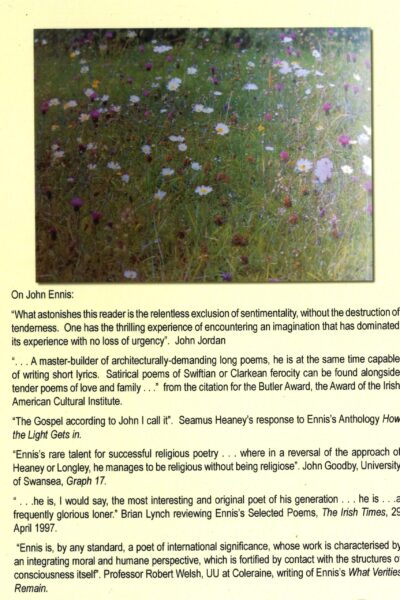
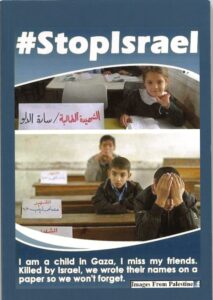
Turangalîla-Palestine |2019
Dairbhre Press
A book of poetry, inspired by the killing of 14-year-old Abdul-Rauf Ismael Salha by Israeli soldiers in January this year, launches in Mullingar, Galway, Dublin, Cork.
Turangalîla-Palestine, published by the award winning Irish poet John Ennis, will be launched in the Black Gate Cultural Centre, St Francis Street, at 8pm on Monday November 25. . .
“The idea of the book dates back to mid-January of this year when the face of yet another dead Palestinian teenager, Abdul Ra’uf Salha, another victim of Israeli sniper fire, appeared on Facebook,” said Mr Ennis. “Something gave in me then to respond with some kind of measured coherence, and in that instant the book was conceived”.
“Turangalîla-Palestine focuses on the very recent dead of a contemporary conflict, the casualties of The Great March of Return. Just as children in Palestine wrote the names of their dead schoolmates on pieces of paper so they wouldn’t be forgotten, so poets in the book wrote poems under named victims so that they, known as the martyrs, would be remembered.”
Just as the school kids on the front cover wrote the names of their dead schoolmates on a piece of paper so they would not forget them, some contributing poets to the book (including an Irish Poetry-Slam Winner) wrote short poems for named Palestinians killed by Israeli colonizing forces. Why? So that their Palestinian names will forever be remembered.
The anthology has verse in English, Irish and Spanish, by thirty poets, with Canadian First Nations and verse in Arabic and quotations from Palestinian poets. The book is a tribute to the bravery of Palestinians resistant in the face of impossible odds as in the back-cover photo. In the words of poet Tamim Al Bargouti writing a poem on fourteen-year-old Faris Adeh, who died facing a tank, “I didn’t write anything. I just read it off his feet” (p.111).
The Dublin launch will include music and readings of lists of those killed in the Great March of Return and Gaza Bombings. The book comes with artwork by Mohammad Sabaaneh on the plight of Palestinian women and the fate of kids. The book marker has a quote from contemporary poet, Dareen Tatour. The present State of Israel is appealing her acquittal at the Supreme Court for her poem “Resist, My People, Resist Them”. . .
I don’t like you, death
But I’m not afraid of you
And I know that my body is your bed
And my spirit is your bed cover
I know that your banks are narrow for me
I don’t love you, death
But I’m not afraid of you.
These lines from Samih al-Qasim’s “I don’t like you death” (p. 117) sum up the raw courage of the teenager on the back cover of Turangalîla-Palestine, an anthology of Protest Poems assembled by editors and midland poets John Ennis (Coralstown) and Offaly-based David Mallaghan. . .
At a recent Limerick School of Music launch of the book, Leaving Cert student Jack Lynch played his music for the victim and recited that poem in his honour. Both front and back covers come courtesy of exiled Palestinian Hamzi El Alami, whose ancestors defended Jerusalem against the crusading butchers of the day.
Greágóir Ó Dúill’s “Seal ag na Crosáidí” compares western interventions then and now. The editors would be happy if the Stop Israel featured on the top of the front cover resulted in one death less among Palestinians from colonising forces whose policy of “incremental genocide” (historian Ilan Pappé’s phrase) continues yearly.
The Gazan school kids on the front cover wrote the names of their murdered school mates on pieces of paper so they would not forget them; poets in the anthology wrote their poems in solidarity with named casualties, mostly young, so that their names will be remembered forever. In time, their executioners in the lofty sniper towers of today may face their own Nuremburg.
Ireland suffered the Tans for a few years; Palestinians have suffered their equivalent since 1948, the year of the Nakbah, or catastrophe. The book critiques why all this is happening with the tacit connivance of most western governments.
The Mullingar event (6.30pm, Tuesday November 12) is on the publisher’s home patch after launches in Dublin, Cork, Kilkenny, Waterford, Limerick and Tullamore, with further evenings planned for Galway, the North-West and Ulster. Mullingar comes courtesy of Cailín Gallagher in Mullingar Library, Westmeath County Buildings.
The title? Turanga is a Sanskrit word suggesting time the eternal at our backs and to come, lîla as in event, say, the launch of the book in Mullingar for a special people, the Palestinians. . .
(Paul Hughes The Westmeath Examiner)
In her address at the launch, author Ruth Illingworth noted that it was important that the names of those killed should be remembered, that in naming the Palestinian dead, their humanity was being restored to them in response to the way they had been dehumanised by their killers.
The act of naming and remembering was similar to the recently published book by Joe Duffy, ‘Children Of The Troubles’, in which the child victims of the Northern Ireland Troubles are remembered and written into history, having been largely forgotten about by all but their families. “So it is in Palestine too,” said Ruth.
She also spoke about some of those named in Turangalîla-Palestine, in particular, the young nurse, Razan Al-Najjar, shot as she looked after wounded demonstrators, and five-year-old Inas Shawket, deliberately run over by settlers in their car.
She also mentioned the teenage boys killed while protesting at the Gaza Israel border – “lads who should have been in school with all their lives in front of them” – and quoted Sheelagh Murnaghan’s statement that “discrimination is something to be angry about”. Ruth concluded her remarks by remembering all those named in the book and “all the other Palestinians killed since 1948 “in the Israeli-Palestinian conflict. . .
The book features verse from Ireland, England, Spain, Germany, Canadian First Nations and an Algerian High School student, Bouras Brahim, in Arabic and English. Art work is by Mohammad Sabaaneh, fruits of his own incarceration.
……………………………………………………………………………………………………………………
FURTHER THOUGHTS ON THE CONFLICT:
REBUILDING THE FUTURE. GAZA GROUND ZERO.
John Ennis, 30 November 2023
for Ilan Pappé
Sometimes from despair, and a people or peoples traumatized, as are Gazans and Israelis presently, can real hope dawn. A cliché, maybe, but a future where in the words of a Nobel Laureate, hope and history can rhyme. And be seen to rhyme. Certainly it is better to light the candle than wrestle the present darkness.
Might such hope be possible, not only for Gaza now, but the whole of the Promised Land of mythical antiquity, the land that stretches historically between the River Jordan to the Mediterranean Sea beyond Gaza?
Talk has turned again toward a two-state solution for the majority Semitic populations of Palestinians, and Israelis, with others, living on that stretch of land. But where is the Solomon, who can divide this stretch of land to the equal satisfaction, and security, of either population?
First, for me, it’s best to start with a definition of the terms “Semitic” and “Semite”. My Concise Oxford Dictionary (page 1151) offers: “Semite (Member) of any of the races supposed to be descended from Shem (Gen. X 21 foll.) including esp. the Hebrews, Arameans, Phoenicians, Arabs and Assyrians . . .Gk. Sém, Shem, -ite.
A good start, maybe half the battle. Why not share The Promised Land between Arabs (Palestinians) and Hebrews (Israelis), with others, who want to live there together in peace? Where tanks and bomber jets are beaten into ploughshares. An equally shared land of harvests and waste places suitable for building on, shared languages given equal status, sign posts in both Hebrew and Arabic, cities and towns with dual names, as in present-day Northern Ireland until recently a place of strife and division, where, say, Derry City is a place name for some, Londonderry for his or her neighbour, Doire for Gaelic speakers? The new Promised Land for future generations with agreed civic structures and governance for all, where people eschew violence, or threat of violence, as a means to settle differences, violence not only of arms, but that directed towards property appropriation or dwellings, with a freeing of political prisoners. An accepted police force (as in Northern Ireland) to assist with civic order, and the withdrawal from daily life of the military. A place where all apartheid practices cease, and dividing walls as in old Berlin, come tumbling down.
Where aircraft from abroad can touch down at Tel Aviv to dual alternating greetings in Arabic and Hebrew: Welcome to Israel, Welcome to Palestine. As one is greeted touching down in Canada in both English and French.
Is such possible in the “Promised Land” for future generations? It had better be or have both present-day and future generations face a future of shared barbarous violence rather than a deserved accord. Populations sick of being sick with their addiction to force as a means of settling differences. The Hydra heads that will inevitably sprout from settlements by violence.
I touched on such sentiments in the poems comprising Gaza Ground Zero (2015) and in the Introduction to Turangalîla-Palestine (2019).
Such thoughts struck me again a few days ago when I saw a social media post of two young Israelis saying they wished to live in a future Gaza. Why not? Why should young Palestinians not feel free to live and worship or not and come and go also, say, in any part of present-day Israel, say Jerusalem, the Arabic Quds, or Galilee or any other of the Semitic lands familiar to readers of the Bible?
Pragmatically, any peace solution must have workable and attractive dimensions to all to grab the attention, and win the confidence and assent of present warring parties. A solution that is built on the better instincts of all. A win-win situation for both Palestinians and Israelis. And one founded on a shared bedrock of wisdom and mutual accord.
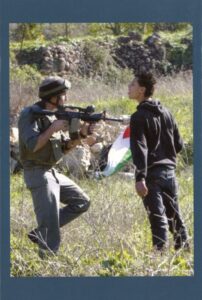
Going Hom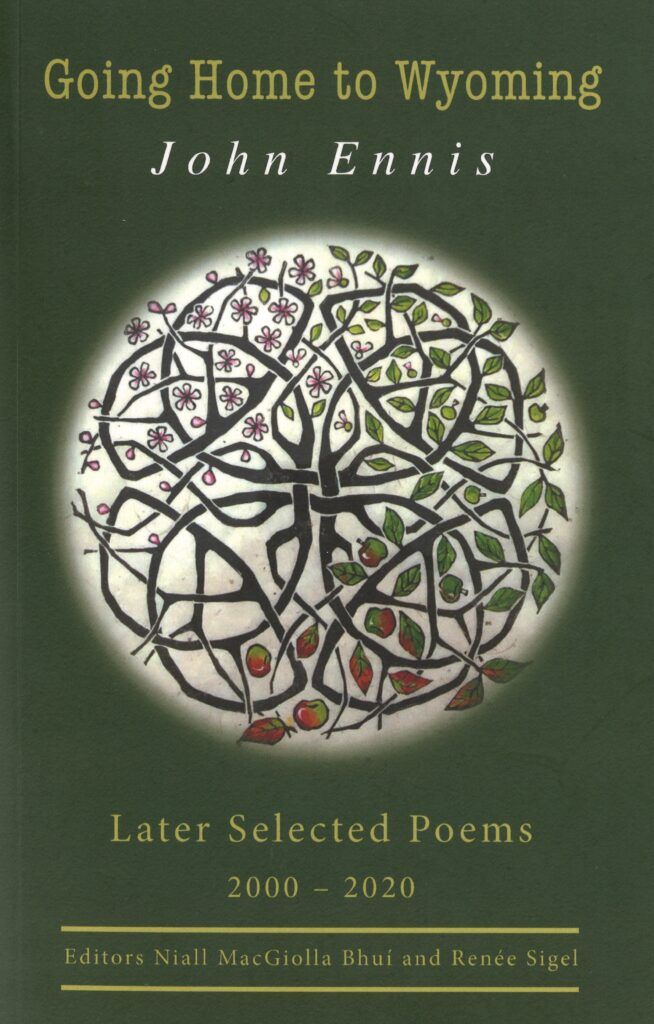 e to Wyoming – Later Selected Poems 2000-2020 (Bookhub)
e to Wyoming – Later Selected Poems 2000-2020 (Bookhub)
John Ennis
Munster Express | 23rd Mar 2021 | Art & Literature, Entertainment
Liam Murphy
The Book Hub Publishing Group have produced another milestone in the diverse and inspirational literary career of John Ennis with, Going Home to Wyoming (Later Selected Poems 2000 – 2020).
The work John Ennis has done as a poet and educator (Head of Humanities at WIT) has marked him out as a committed humanitarian to many causes, local, national and international. He has edited and co-edited international anthologies linking Newfoundland and Canada to Irish and European source material. This alone assures his place in the pantheon of academic achievers and literary luminaries.
The selection is taken from 14 books and was made by the co-editors Niall MacGiolla Bhui (Book Hub) and Renee Sigel (Rare Swan Press). I love the cover with its Apple Tree Celtic Knot, outlining the complexity and simplicity. The title poem is full of references to the poet’s diverse interests like a reflective “subversive of subversives”.
Today Ennis spends his creative time between Waterford and Mullingar, and I have a crazy vision of him on his High Horse, crossing the Joe Dolan Bridge, ready to do battle with words to remember a vanishing tradition, to acknowledge his roots, and family influences, and to remind people of the restless and possibly, ceaseless inhumanity of the world.
There is a dipping in, here and there, to a storehouse of words, and the persona words that embody stories, like in ‘Varuð’ where Diarmuid shares with Grainne “there is no rational explanation for all this – what can only be engendered with a mere kiss or what comes with a partner, every little geis, the other asks for, sometimes paradise. We soared”.
I love it when poetry raises me up and allows me or forces me to overcome fear or hesitation and soar.
The parade of imagery is impressive and humbling at times. A poem about idealism in a seminary can shout “Bollocks Jerusalem. Bollocks the Fad. Fintan didn’t give a god-damn”.
The next poem looks at ‘April Fools’ Day’, and a hundred soldiers come to knock down the house of Nureddin Amro.
A page later, we are in Tienanmen Square “not knowing what comes next”.
What comes next in the book is ‘Pelar La Pava’ about killing turkeys for Christmas. “The turkey money bought the winter coats”. Another image from the same poem “ready for the old man’s cart into Mullingar: their great country breasts as plump as nudes from Rodin”.
John Ennis’ collection Tráithníní in 2000 was a revelation, the short line, the beauty like a spine down the page, and I quote one poem in full, (all short lines run together) “And I remember your face on the pillow a quarter of a century of your spine, how love swerves in curves, beauty flexing like a bow, my lips on yours, your lips on mine”. Wow!
The last poem in this selection is ‘Live Life Magnificently’ and the last line: “Poetry, a warehouse where Gods are moved”.
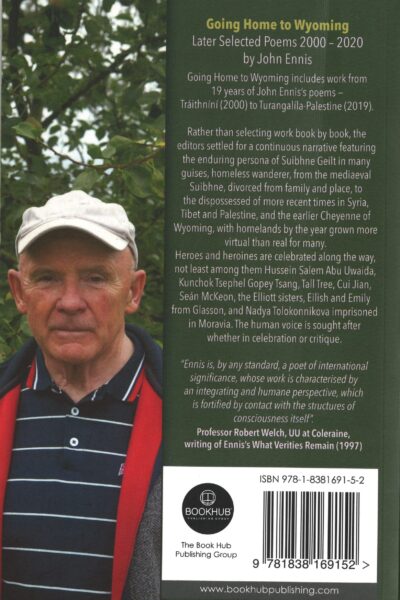
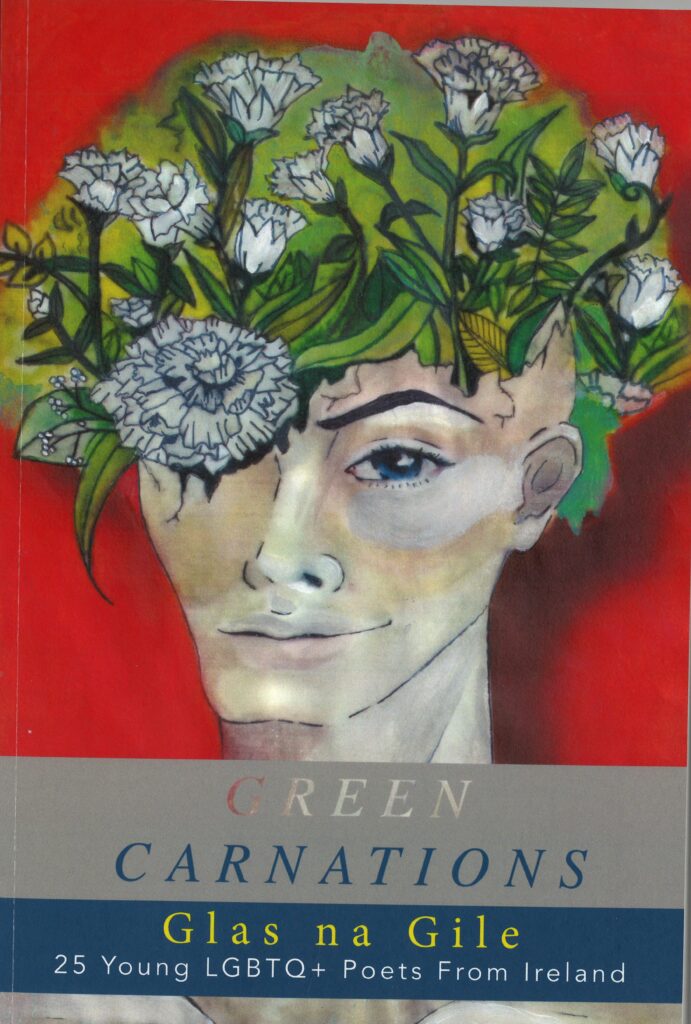
New Irish poetry anthology sheds light on the LGBTQ+ experience in 2021
‘Green Carnations, Glas na Gile’ is an anthology of verse from 25 contributing LGBTQ+ poets from all across Ireland.
BOOKS18 FEBRUARY, 2021. WRITTEN BY KATIE DONOHOE.
The recently published Green Carnations, Glas na Gile, is a fascinating anthology told through the voices of 25 Irish LGBTQ+ poets, capturing the queer experience today.
The anthology charts the ups and downs of first loves, longer partnered relationships and sexual encounters, pleasure and pain, self- reflection and celebration, all through the talents of a diverse range of LGBTQ+ folk.
Speaking of the origins of the LGBTQ+ poetry anthology, editor John Ennis shared, “The book grew out of a conversation I had with UCD student Moxie Lofton, who organised A Walk-in Poetry Workshop in Dublin in late January 2020. I wandered in, I might learn something. During snatches of intermittent conversation, Moxie remarked on new-found confidence among young LGBTQ+ poets about expressing their innermost thoughts and fears in the minefield of relationships.
“Having edited and published a number of anthologies, I suggested maybe there was a case for bringing out a modest pamphlet of poems reflective of this? We met a few times later to suss out the idea: Covid intervened but the notion gathered pace, eventually after many twists and turns ending up in a book of 198 pages featuring 25 poets.”
To celebrate I found a place at a bar. A lady
thanked me for all my dead legs, bleeding toes.
She could not have stomached asking people
to allow her marry her girlfriend.
My heart swelled with pride.
By nightfall I was with my friends,
drinking cocktails. I felt like a full citizen
of this country for the first time.
An Indian summer came early.
We lit paper lanterns.
They floated up and away
under the woolly clouds.
Count Day (an extract) – Diarmuid Fitzgerald
Ennis continued, “This bi-lingual anthology of 25 young LGBTQ+ poets living in Ireland disproves the notion of the stereotypical ‘gay’ still in the minds of many people, not least the ‘objectively disordered’ person of religious catholic fundamentalism. Some poets in the book still bear the scars of these put-downs.
“Each voice among the 25 is varied in itself, to begin with, and then flowers with that individuality, among the others, as the verse unfolds. In their own motley ways, the poets are ‘proud to be gay’, despite the fight some have to fight daily to defend their right to be gay, as individuals, human beings and fully committed members of society with equal rights due in all areas of life.”
Ireland does not welcome that which is strange,
for years ‘abnormal’ men loved out of range
of suspicious eyes and hateful glances,
they escaped from here given their chances.
The land of saints, of scholars, tales, and glee,
some stories were forgotten, never free.
The Song For Him (an extract) – SJ Saighead
There are poems dedicated to supportive parents who helped their children during the coming out process – which is a recurrent theme – and poems decrying the lack of support from extended family members. The creators describe, “Life as lived is the stuff of this book: life with its individual acts of thoughtfulness,” there are moments of self-reflection, scary moments, conversations (including one with a drag queen), and the day-to-day life of living as a queer person in Ireland.
Ennis described, “When Moxie Lofton and I sat down in an attempt to set some parameters for Green Carnations, Glas na Gile, we wondered if there might be traces of the wit of the original Oscar in the poems expected in. We were not to be disappointed.”
I never imagined the freedom
That could come
From being in a room
Surrounded by people just like me.
To know we all chafed at
The gender assigned to us by society
And struggled to find the courage
To truly be ourselves,
Gave me a sense of peace
That I never experienced before.
The minority became the majority;
Confidence and power in numbers.
Lighthouse (an extract) – SH Bramble
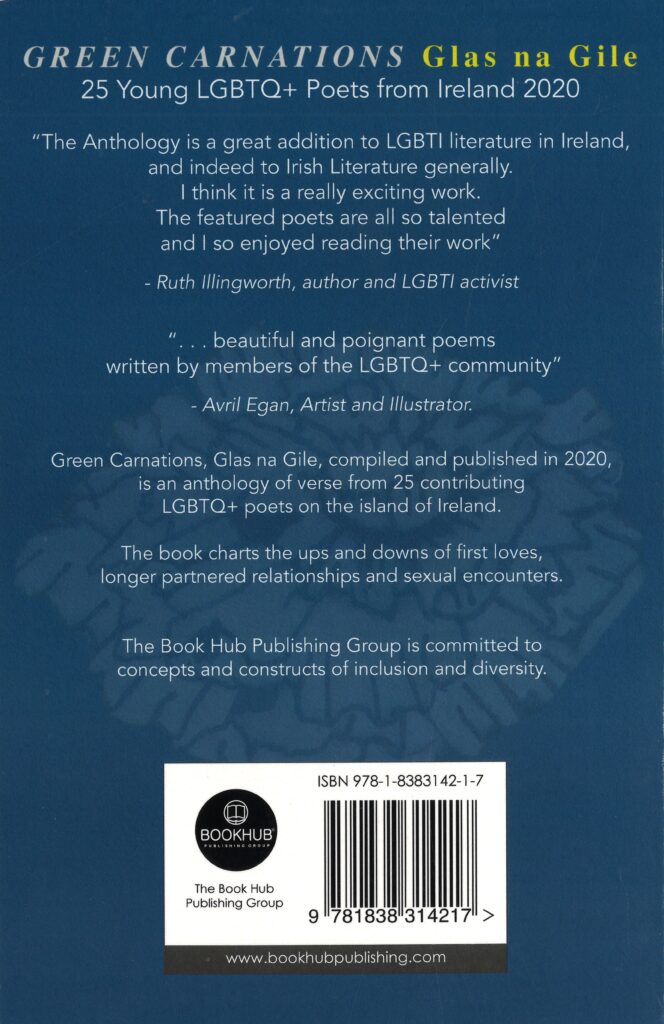
Nine Lives We Hope: Poems for Pussy Riot
John Ennis
For months, Pussy Riot in Voina had been ridiculing in Art Putin’s vain-glorious maleness and Stalin iconization. Their piéce-de-résistance was the forty-second stint in the Cathedral of Christ the Saviour in Moscow, “Punk Prayer-Mother of God” (the phrase “God-shit” summarising Russian Church &State). Their performance caught the eyes of many, and triggered a call from the patriarch to the Kremlin to go-get-them. The women were arraigned in a cage before the court. At their sentencing, as Nadya and Masha were lead away for imprisonment, the women with their beads, who had first reported the escapade, were seen crying reciting from the Prayers for Prisoners composed in the time of Stalin.
64 pages, Paperback
Proceeds to Ukrainian War Relief
Pastures New, Composition
Lines, not recollected in tranquillity, but whenever another flash came via Facebook of Nadya’s imprisonment in murderous hard-core Mordavia, response wanted then and there, yesterday, in the manner of Rihaku, or the Old Irish Filidh, drop in the ocean yet with enough of us worldwide to make a wave, a bothersome comber, verse to “punk” it with the women, stay the prison governor’s boot in the gut: my great joy, as father-to-father, to see my “Jubilate in Punk Minor” Liked by Andri, Nadya’s father on Facebook, when he exclaims “Wow” on seeing his daughter combing her hair safe and sound in Krasnoyarsk . . .
for Nadia, Katya, Maria
What you did is the best icon for our times
For the Galilean, long lost in credal factions, arguments over bread
Who strode in like yourselves, Hooligan, caused a riot in the temple,
For that droopy-eyed female of the males his mother’s long become
For self-serving artists hosting after finance from the sanctuary,
Mary who called her other kids after revolutionaries the Romans killed.
But when you climbed up under them to punk on the altar
Where the Blasphemer, and his apostle Voltaire linger still –
I will defend to the death your right to say what you will –
They might have added where, and if one could sing it all the better
For Putin, Kirill, caught up in their own whirlwind.
But you’ll endure, even if caged all day in the mind
Crushed now to apologise. Nor will he matter, Nikiforov,
Nadia will, and Gera, lost these dark days for her love.
(On 18th of October in penal colony IK-14 Nadya met her ex-lawyer Violetta Volkova. Nadya become suspicious of her and asked her to leave. After, Nadya gave her Lawyer a letter/statement: I, Nadia Tolokonnikova , born in 1989, refuse the services of lawyers: Volkova VV, Polozova NN, Feigin MZ for the reason that I suspect them of personal contacts with the leadership of Federal Penitentiary Service of Russia. Signed Nadia Tolokonnikova, 18.10.13)
. . . from Introduction To Nine Lives We Hope, Poems for Pussy Riot
No space, or time, to tread softly in the house shoes of poesy. Put on yer stomping boots. Lift your knees. While Yeats was writing his early stuff on Innisfree, even at the end in his phallic tower, Lady Gregory’s tenants were paying the bills. Easter 1916 was written when it was politic and advisable to do so. Future of the big house and all that. Poem a tat overblown. A wax museum. Even the revolutionaries didn’t see themselves in such a green light.
The people like Masha’s, limp in the grip of Privilege and Religion. Mostly descendants of ex-tenants. Yeats’s cold eye and his hopes for Eugenics would sort out their futures.
Caithlin Ni hUallachain, in kimono, could then be adored without trespass on every clearance on every hillock, mountain and plain.
The Chinese poets of the middle ages had more in common with ordinary people than many current poemsters.
Years ago, Paul Durcan wrote a collection of poems entitled Going Home to Russia. In both places artists with any dare are caught in the closing pincer of state and church. Kavanagh grows old eating out of the paw of McQuaid for a tosser or two. Clergy close in like jackals at his funeral, the afters of his verse. The censer-swingers come out in force playing the altar for our dead nobel laureate. Nauseous. Nausea, come back Sartre. An episcopal retiree stands at the altar rails preaching O’Driscoll. Lucky my hearing’s poor. Bells, bells, bells galore. An Egyptian export. Every corner of the country. Bards, O’Brudair’s line, continuing into the corporate beyond. Academia Ltd. Aosdana. Ltd. The Indomitable Irishry.
I want to write poems like the paintings artists painted on the rough walls of the catacombs. My kind of gallery. Continuous with what went on, goes on, above. Praising the halo-slipping saints of the real. The women, if they wanted to, officiating as equals. Female bishops further safely down. Mary of Magdala, between clients, ranting at the eleven. Her partner tucked in an ossuary. Their kids making their own way. Keeping their heads down among the Ebionites. Orpheus and Yeshua breaking bread together. Acting David and Jonathan if they wanted to. They knew the Day of the Lamb wouldn’t last. Basic Instinct. Handelic Victory and Power and Heavenly Kings and Queens. Byzantium Abú. Emperor, Fuhrer, Duce. Czars. Papas. One language, that of the smiling jackboot walkabout. Speak free like Diana and be left to die in your car. Your innards ripped. Nobody the wiser. Ever.
Off-rhyme, half-rhyme, bad rhyme, pathetic fallacies, no rhyme, parallelisms , dissonance, doggerel, OBERIU snapping at the heel. Poems, immediate, the present continuous. Scant A4 for the toilette of reflection and tranquillity. Out with commemorative manipulation of what is. Cop out. The worst is happening now: the kicks in the gut for Nadya if we don’t shout up together. And even then. The majority need helplines to an authority beyond themselves and would rather opine forever on a few women let loose in the golden sanctuary. At the reading in Dublin for Pussy Riot, the argument ran: keep the verse moderate or it will further antagonise Vladimir (if he, or the antennae of his advisors, even advert to critique). No, assail him at every corner. If the reported words on Mordovia are anything to go by, the latter strategy was the correct one. Verse, art, music and outcry do make a difference, if coordinated. At least to date, neither Nadya nor Masha has become another statistic like Anna Politkovskaya, one of Putin’s more stringent critics, murdered and her body dumped in a lift on the president’s birthday. The president’s reported comments on her murder: “She was a nobody anyway.”
Russian Officialdom is right when it refers to the public outcry over the Pussy Riot knees-up in the sanctuary. In the same way in Jerusalem the crowds that cheered Yeshua riding on his humble hinny into the city were yelling within days Crucify Him. His running amok in, and taking over with his mates, of a sacred precinct for the whole day, disrupted their Passover Schedule, what they’d looked forward to, travelled from afar to, and probably saved for the whole year. Yeshua and Nadya live on different planets from those caught up in the backwash of their antics. Yet, within a few weeks, the mood in the poorer streets of Jerusalem changed; babbling together in different tongues, people began to acknowledge what Yeshua stood for. Closer to these parts, when news of the 1916 executions reached the ears of the Irish MPs at Westminster, they cheered with the news of each death and banged fists on their benches in approval. But by the time the authorities had shot an injured James Connolly in his chair just to finish the job, clean up the mess, bagging quicklime on him too, their tide had reached a high point. Consigning Bin Laden to the depths ensures he will rise again. By the time the Moscow show trial ended for Pussy Riot, orthodox supporters in tears outside the courtroom were praying for the women from booklets of prayers long compiled for Russian prisoners. Too late to save Nadya from Mordovia or Masha from her fate.
Authority. Magnanimous in Victory. Were there not four of the Pussy Riot twenty-two in the sanctuary? One slipped the net. Another was freed (well, really, she was reportedly apprehended by security before she reached the sanctuary ) with an admonition for good behaviour in the future in holy places. Masha had seriously disrupted the plans of prime minister Meredev to build a mansion for his wife in a major nature reserve. Putin admitted in an interview with Merkel that it was the ringleader Nadya he was really after. The Orthodox Establishment, cute as christians, promised to pray for the women and to forgive them. Who knows in time, they might even elevate them, suspend them on high, in Christ the Saviour, up beyond eye level, like bothersome Elizabeth, who’d campaigned for a return of the female diaconate. Or have their hack sculptors give them doleful eyes like Magdala.
Verse in the face of this shit can only have the quality of a D-Day bombardment. It would have been politic if the warships in the Channel could have yelled through their megaphones:”Go back to where ye belong” and the Nazis obliged as asked. Saved tens of thousands of brave lives who came across the Atlantic, laid down their lives for people, us, they’d never know. Sometimes the act of rebellion against the status quo is called for, the excising of one more tumour from the body of humanity. Which is why we have whatever freedom we have today in these parts. I have tried to come to terms with this fact in the poem “O When the Saints . . .” in a country which sees as a joke the aphorism “Which side were we neutral on?”
But the job was not completed. Within months, the Vatican was facilitating the escape routes of its soul sprites to Argentina and elsewhere, according to documentary after documentary. If one thinks that a line like “Putin and his Kirrill snot” is harsh, then he or she forgets that failing to excise a cancer will in time lead to the spread of devastating secondaries. The bombardment must go on. Until universal human rights are won. Those of women are a case in point. It is no accident that the stated purpose of Putin’s recent visit to Francis in the Vatican was a closer all-male linkage with the Russian Orthodox. This at a time when the latter is held in growing universal disdain for the part it played in the incarceration of Pussy Riot. Such means little for a man that fraternised with Videla, while Benedict, no White Rose, before him slipped out of being a Nazi only on the news of Hitler’s death. No news either, that Francis was runner up to Benedict at the latter’s manipulated conclave. That we have this Snowden-like glimpse into the impenetrable darkness that are the conclaves, is indicative of a gleam of hope. But whether there is any infant Yeshua to clean out the stygian stable that is the Vatican is unlikely. The St. Peter’s mob is too busy chanting Francis, Francis to worry about the Videla figure at the upper window. Though, better PR, and a camera over the shoulder, so that the left hand knows what the right hand is doing, and the odd quickie selfie work wonders. Pity the Galilean wasn’t so equipped. But he gave the Videla of his day the perfect answer when frog-marched into his presence. Silence. Refusal to acknowledge.
Ultimately, Christ the Saviour in Moscow is the People’s Space. Not Kirrill’s. Ditto, the Vatican. Not the Pope’s, the cardinals, that of the dubious oldies with voting power. Vatican 11 established the People principle. But it’s with John XX111 long in the grave. Space for people to vent or pray, or both at once. With no caveat on dress, or none. Headgear, or none. Play the wild Galilean there, who dares, like Pussy Riot.
“He[the Galilean]is demon-possessed and raving mad.”(John 10 :20).
At a certain stage in life, one can be excused for “being young and foolish”. Sixty-nine is stretching it. The journey of these poems with Nadya and Masha from the sanctuary in Moscow to Krasnoyarsk , however it ends, and wherever it takes, has been one of realisation for this one person. I don’t speak for others. I’ve learned that the concept of DIY extends to more than the trade of stone mason Yeshua. When I summoned the persona of the Galilean to Nadya’s side in her dark cell, there was neither bread nor wine. At many a battle front, there was scarce either, but those present made do with scraps to hand. Shared and ate and wet their lips.
I saw all Nadya had to hand was prison slop, but I knew she was communing deeper than any.
Ultimately she’d no need of a priesthood, male or female, or mixed. Not that the boys will ever accept this. Having set it all up for themselves millennia ago, in cold and adorable print, they’d be well on the way out of a job for starters. And those above them. And those above them. And . . . the House of Cards Francis refers to.
My first poem written for Pussy Riot was “For Nadya, Katya, Maria” (quoted) when I spotted the eerie similarity between the Pussy Riot of the Muscovite and the Yeshua of the Jerusalem sanctuaries. The poem was featured in the anthology Catechism Poems for Pussy Riot. Critic H. Giles, in a review of the book, referred to my poem and interpreted the “I” as some variant of a lyric “me” and not the omnipresent Voltaire persona I’d intended. He made the unanswerable point that the verse seemed “a little limp in the face of Pussy Riot’s Punk”. He was probably too polite to say that at best such verse is irrelevant, at worst, patriarchal.
If you can’t punk it, in some measure, —as these poems attempt to do, —with Pussy Riot, forget it.
Because you are neither hot nor cold . . . Sunday 20 Oct 2013
Read where Kirrill is concerned about the loss of faith in Russia —be of good cheer — he needn’t be, it’s D-Day again and some American Evangelicals are winging to his aid—those that believe in modern-day crusades to rid them of bothersome
Heathens so the Christian juggernaut rolls on across the highways of the mind, there are Videlas to be bowed and curtsied to by Francis, Benny has his anti-aircraft guns to man, not ask the names of the latest helpmates from Dachau
Doomed while the kirks, chapels and cathedrals they will fill and empty, all the more intimate spaces where hymnsters meet to praise You-Know-Who, clerics indifferent as the temple head honcho who clambered up that much-trodden hill, saw with his own eyes, through lenses of relief, just one less wannabe-messiah
Nailed for the common good, and now he can hammer the other eleven ranting and wandering the wastes of Judea or wherever, well, I’ve good news for you lot, as bees still live in their hives
Nadya lives, Nadya lives, Nadya lives, Nadya lives, Nadya lives, Nadya lives . . .
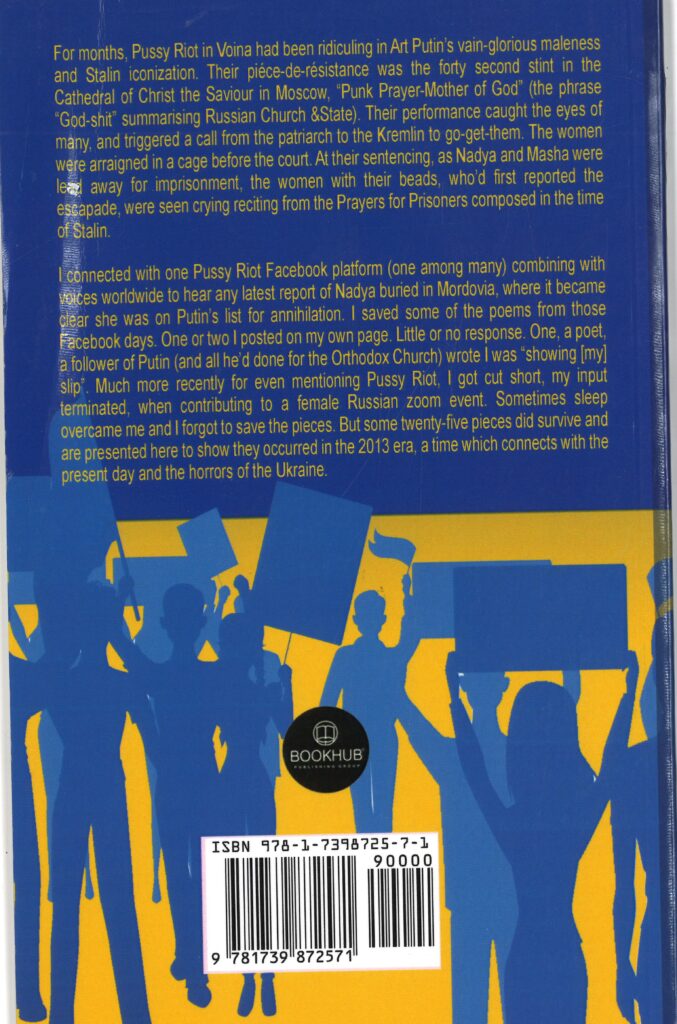
ANTHOLOGIES | Co-edited:
See also School of Humanities Publications (Humanities)
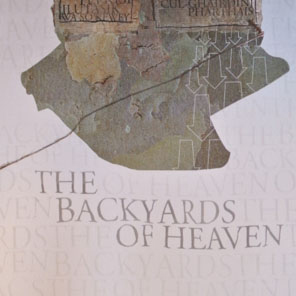
The Backyards of Heaven | 2003

Launch at Kenny’s Galway, editors McKenzie and Ennis
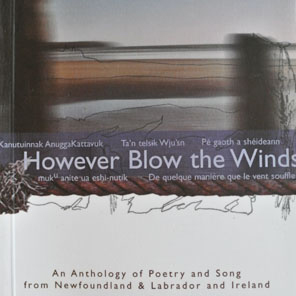
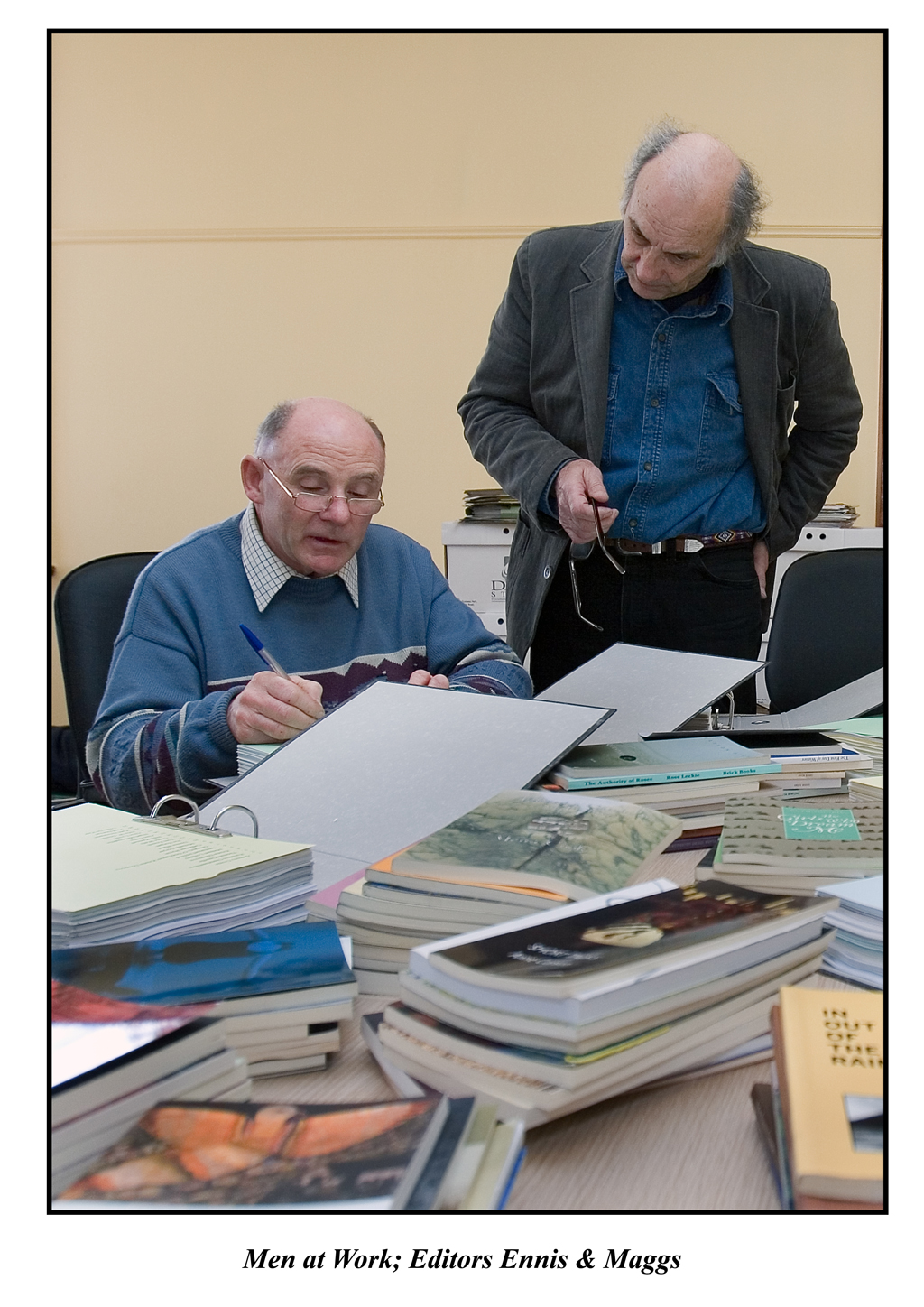
However Blow the Winds | 2004
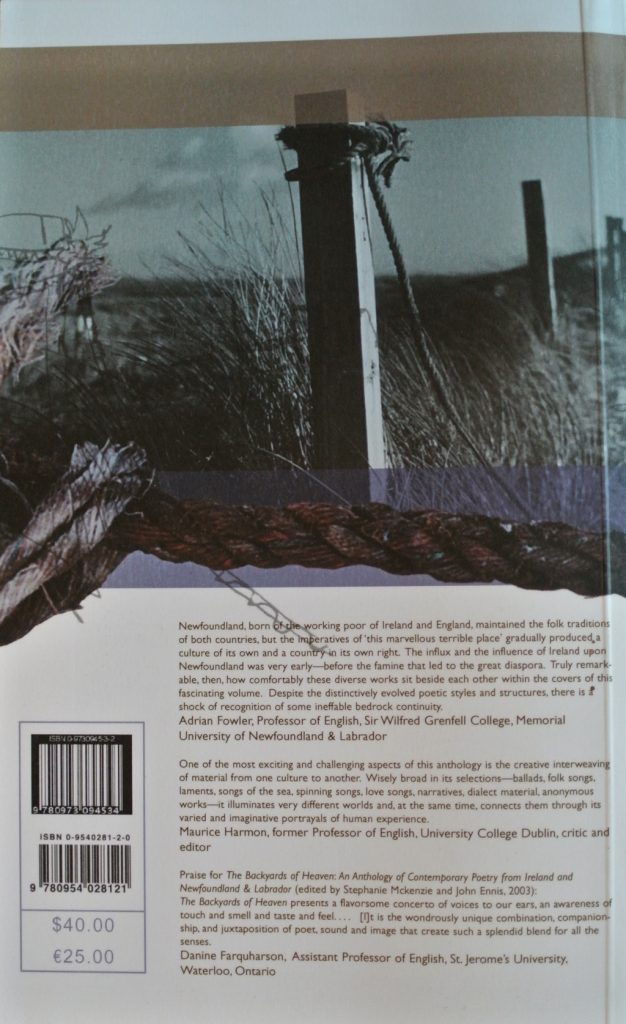
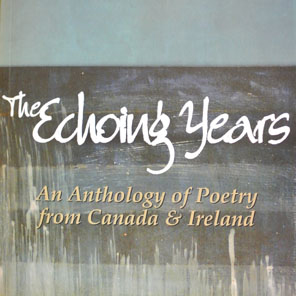

With Kitty Lewis at the Learneds
The Echoing Years | 2007
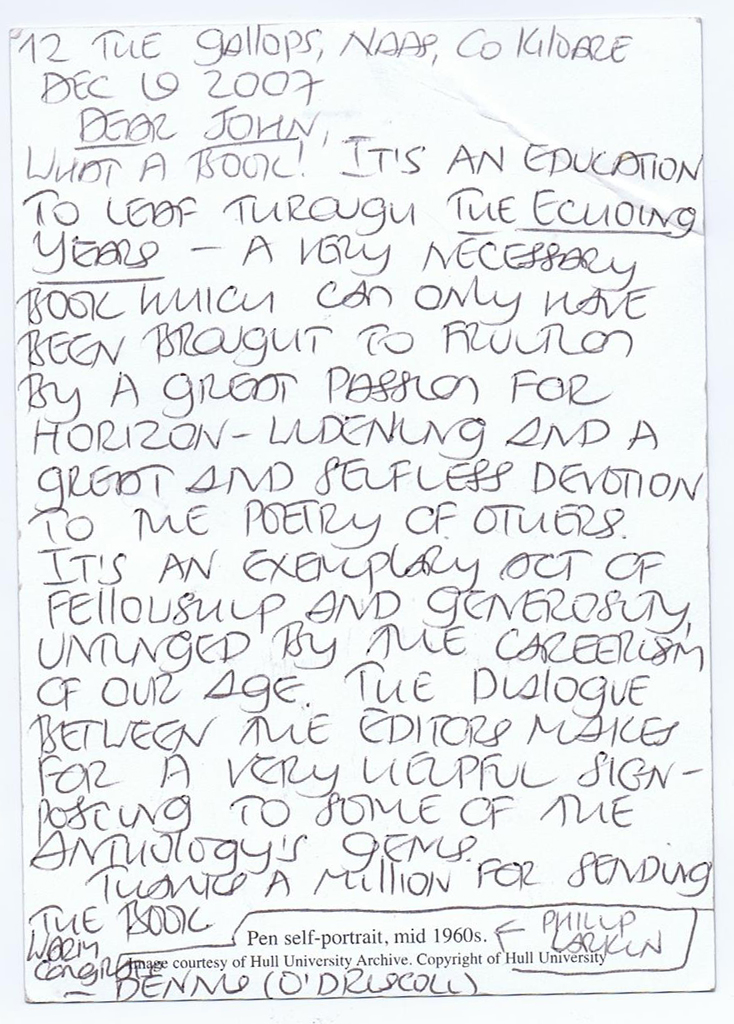
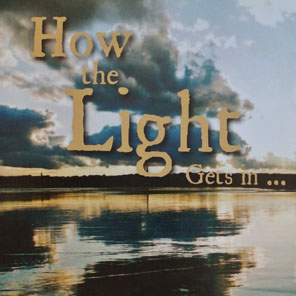
How The Light Gets In | 2009
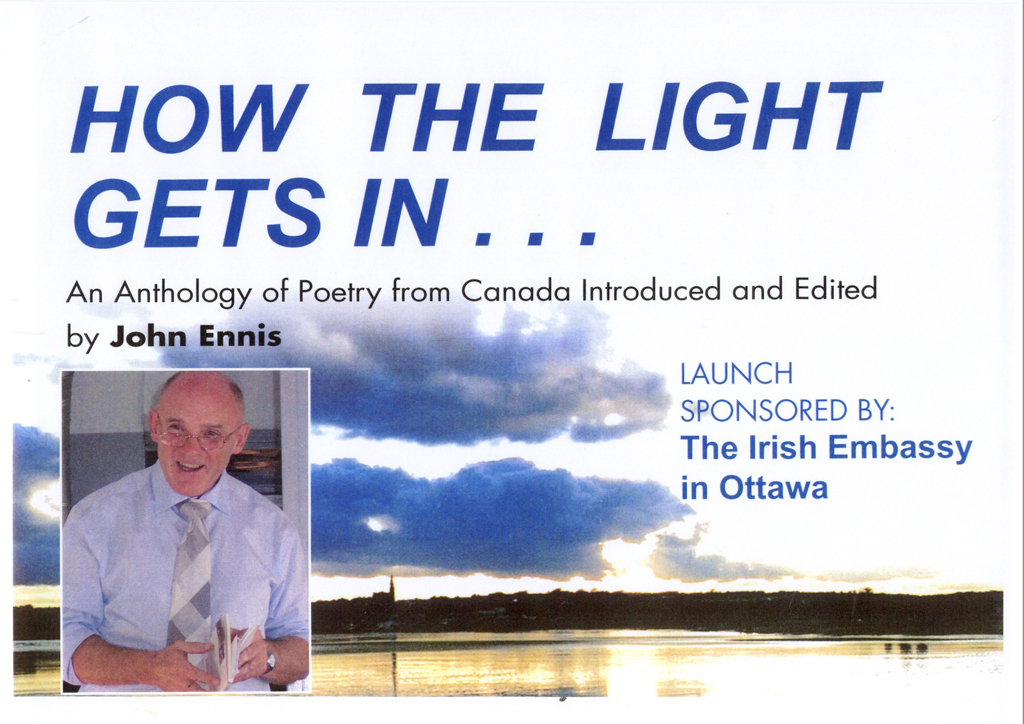
AWARDS
